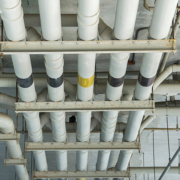Water Systems in Closed Buildings May Require Flushing and Testing
Plumbing systems in buildings closed or vacant for long periods may need to be flushed to safely remove stagnant water.
Water provided by the San Diego Water Authority and its 24 member agencies continues to meet all state and federal drinking water standards. But after water leaves the agencies’ distribution systems and enters private service connections, the water quality can deteriorate if water becomes stagnant.
Most commercial and industrial buildings have been partially occupied even during the COVID-19 shutdown, and HVAC and water systems continue to be maintained and operated even though many employees are working remotely. However, building owners and managers should take special care with plumbing systems in buildings that have been vacant or have had periods of low water use to protect the public and employees returning to work.
That’s because plumbing systems must be actively managed and maintained to prevent bacteria growth. Bacteria can flourish in pipes, fixtures and associated equipment (like fountains, cooling towers and HVAC systems) that aren’t used for several days. Schools, for example, commonly flush pipes before kids and teachers return from breaks.
Building owners should prepare plumbing systems
Water agencies and other organizations are providing public notice about plumbing safety; however, it is the responsibility of building owners and managers to address any related issues on their own properties.
Several steps are necessary to prepare inactive plumbing systems for building re-occupancy, and workers performing start-up tasks should wear PPE and receive appropriate training. The steps involve flushing the entire plumbing system with water and testing to ensure “residual chlorine” levels are within the safe range. Testing to ensure effective flushing is recommended; if testing reveals high levels of bacteria in the system, additional steps are needed.
8 Key Steps for Reopening Buildings
Develop a comprehensive water management program for your water system and all devices that use water. Guidance to help with this process is available from CDC and others.
- Develop a comprehensive water management program for your water system and all devices that use water. Guidance to help with this process is available from CDC and others.
- Ensure your water heater is properly maintained and the temperature is correctly set.
- Flush your water system.
- Clean all decorative water features, such as fountains.
- Ensure hot tubs/spas are safe for use.
- Ensure cooling towers are clean and well-maintained.
- Ensure safety equipment including fire sprinkler systems, eye wash stations, and safety showers are clean and well-maintained.
- Maintain your water system.
The CDC has more details about these recommendations.



